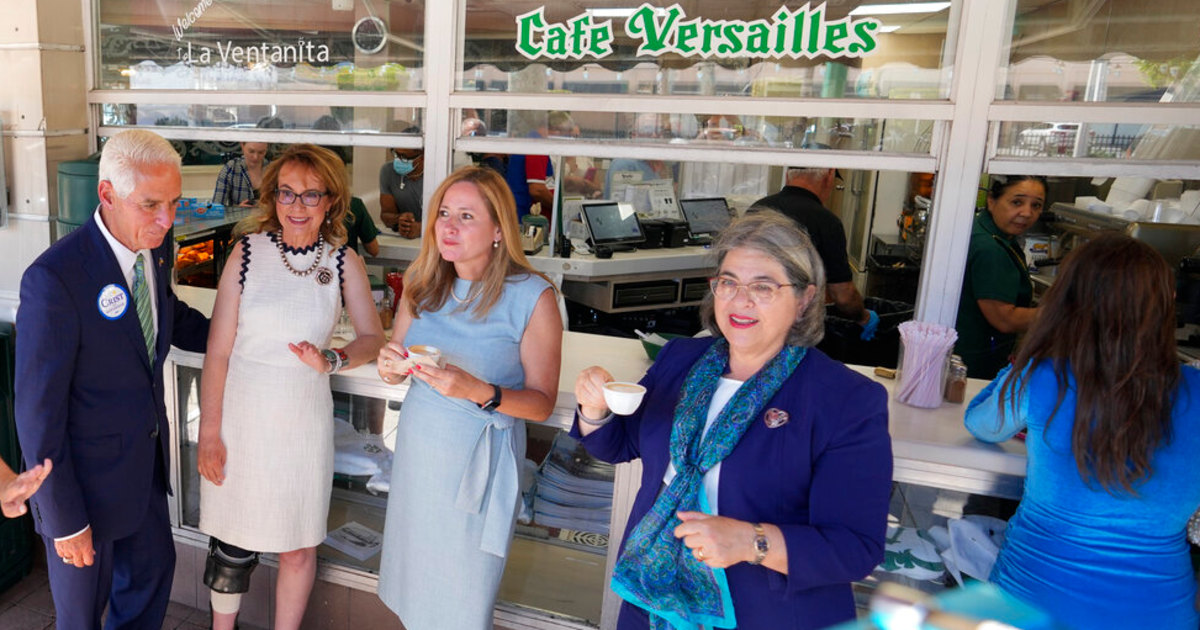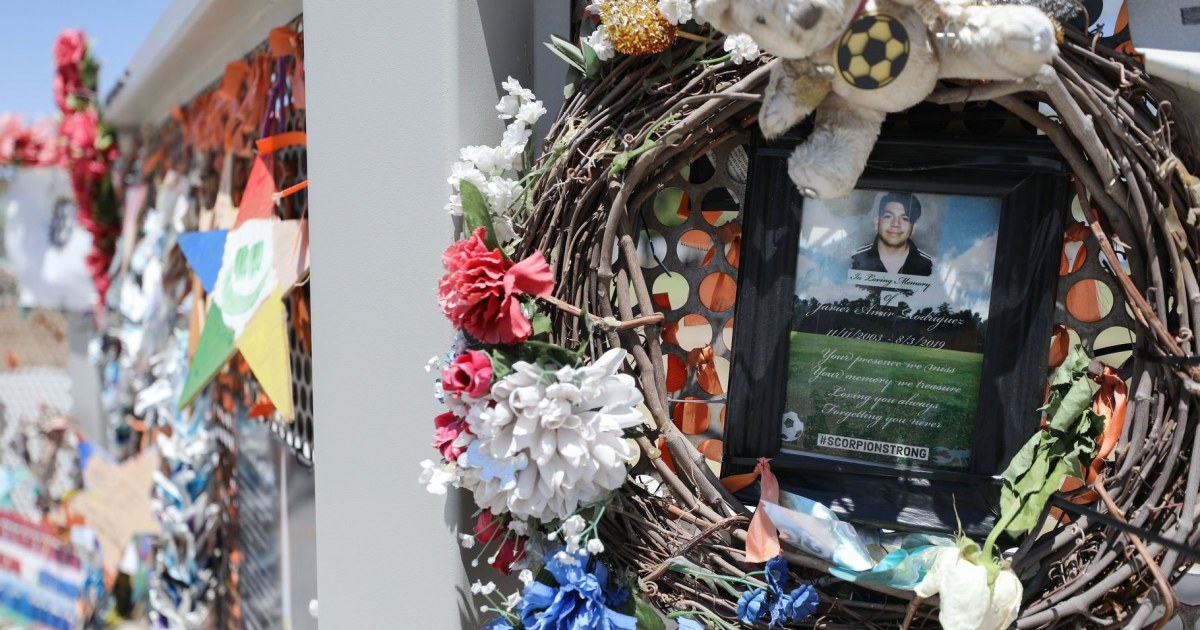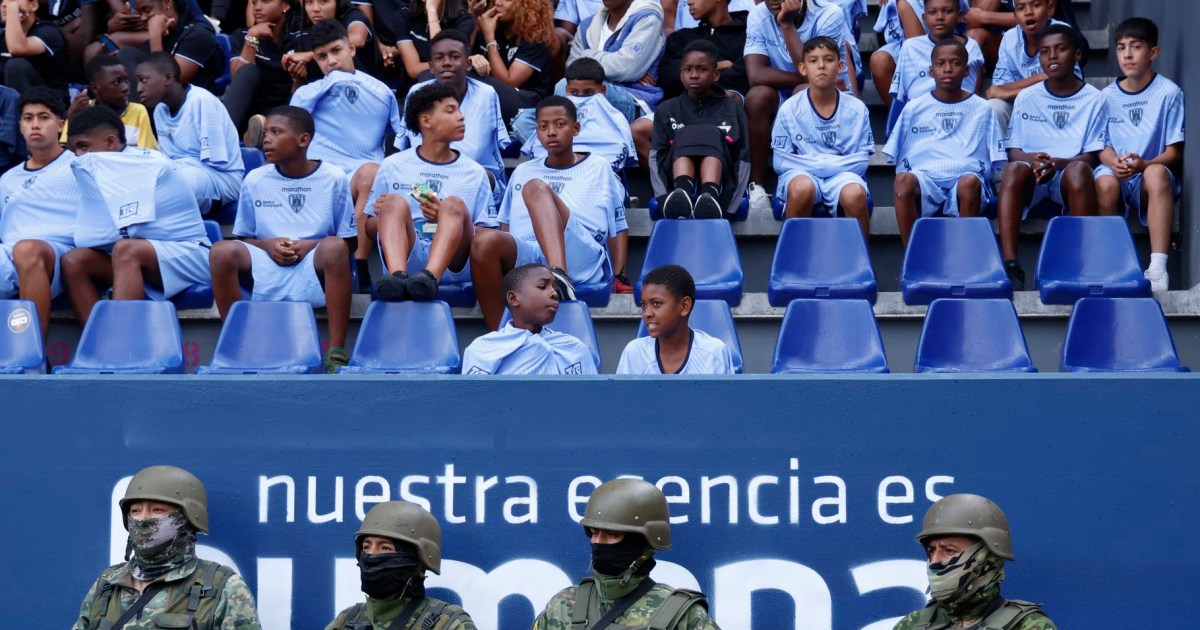Welcome to Axios Latino, a newsletter to tell you every Tuesday and Thursday the stories that have a special impact on Latino communities in the United States and in Latin America. If you are interested in subscribing and receiving the newsletter in your email (
in English
), you can do so
by clicking here
.
We will always publish it in Spanish on Noticias Telemundo.
1 Topic: Doing Justice with Bones
People under nameless graves and in mass graves
around Latin America are slowly recovering their identities, in some cases decades after the conflicts that took their lives.
Some of the nearly 300 crosses in the Darwin cemetery, in the Falkland Islands, where soldiers who died during the 1982 war lie. Many of the graves read "Argentine soldier known only to God." Martín Bernetti / AFP via Getty Images / Getty
News Boost
: Six Argentine soldiers who died in the Falkland Islands during the 1982 war against Britain were identified last week thanks to forensic anthropology and genetic testing.
The identification process is part of a project endorsed by the International Committee of the Red Cross.
Five of the six newly identified soldiers had been buried in a single grave, which only had a plaque that read: "C.1.10: Argentine soldier known only to God."
Why it matters
: Identifying sometimes minuscule remains helps build court cases, as well as bring peace to families who have had a suspended mourning by not knowing definitively whether their loved ones are still alive after being disappeared.
This technique, which largely began in South America, has now been used throughout the world.
The Argentine Forensic Anthropology Team (EAAF) was founded to find the trace of the thousands of people disappeared by the 1976-1983 dictatorship. Since then, it has assisted in investigations of migrant deaths on the border of Mexico and the United States;
in the identification of persons disappeared during Apartheid in South Africa;
people killed in the Central African Republic, and more.
A similar team in Guatemala has so far managed to find out the names of 3,700 people who were massacred or disappeared during the three-decade civil conflict.
Mexicans in search of missing persons visit an extermination camp in Los Zetas: "Those ashes are our relatives"
Feb. 28, 202002: 28
Forensic anthropology has been key to the trial for the El Mozote massacre, when a thousand people were killed in El Salvador by the Army.
In the criminal proceeding for the 1981 case, evidence obtained by reviewing the mass graves has been presented.
In Colombia, a similar process will be used as part of the National Plan to Search for victims of the guerrilla conflict of more than 50 years: they will begin to search among remains buried anonymously in various cemeteries.
Between the lines
: Some of the people who do the identification work do not have professional training, as is the case with the various groups of
search engines
in Mexico.
They are women in search of loved ones who developed, with trial and error, a method to find remains in the death camps of the cartels.
They insert a metal rod to a certain depth;
If when you take it out it smells rotten, you know you have found remains.
There they begin to dig with their bare hands, waiting to unearth, perhaps, the missing loved one.
The Mexican authorities, meanwhile, assure that they cannot carry out the searches because they are exceeded, given that official estimates point to more than 85,000 missing persons since 2006 and more than 1,600 mass graves found in just the last three years.
2. Hispanic Heritage Month: a very special footprint from Argentina 🕵️♂️
To solve a case, you have to look for fingerprints:
this criminalistic tool used around the world was developed by an expert in Argentina.
A fingerprint being studied in a laboratory in Moscow, Russia.Sergei Karpukhin / TASS via Getty Images
Why it matters
: We owe the technique to police officer Juan Vucetich, who introduced the use of biometric data to solve crimes in 1892.
Today, searching for fingerprints at a crime scene is still elementary, Watson.
A report from the National Institute of Justice, a US government agency, indicates that it is the most collected forensic factor in crimes ranging from robberies to homicides.
The report indicates that convictions are more likely in cases where biological evidence, such as DNA remains or fingerprints, was collected.
In detail
: Vucetich's fingerprint classification system was first used to solve a crime 129 years ago.
The person responsible for the death of two children was found in Necochea, Argentina.
Shortly after that investigation used fingerprint evidence in unprecedented ways, the practice spread around the world.
In summary
: Before the fingerprints developed by Vucetich, the only system that was used was the bertillonaje, or anthropometric, which consists of having the measurements of the extremities (arms, feet, the size of the head) to identify the suspects.
That technique has been adapted to include measurements, such as height, in current mugshots.
Beyond Hispanic Heritage Month coverage:
In full color, thanks to Mexico
Peru feeds the world
3. Latino Professionals Demand: Go Beyond Words
YouGov data for LinkedIn;
Axios Visuals Charts
Half of Latino professionals in the United States
feel that their workplace does not provide a suitable environment, even though most believe that bosses consider inclusion important, according to a poll conducted by YouGov and LinkedIn.
In figures
: 37% of the professionals surveyed said that they are thinking of leaving their current job due to lack of recognition, lack of opportunities or a leadership that has similar experiences and can give them guidance.
Additionally, one in four workers plans to leave their post-pandemic job in what has been dubbed the Great Resignation.
[Financial advice for those who want to change jobs]
Bottom line
: The survey shows dissatisfaction in the workplace and the feeling that people of color are being restricted despite promises made by companies to diversify and work for more equity after the racial justice protests.
51% of respondents indicated that their company talked a lot about making changes in the internal culture but those adjustments and reforms did not happen.
Notable
: 60% of respondents said they feel they are missed when it comes to career development opportunities, such as promotions, because of factors such as accent or skin color.
The figure rises to 70% among Latinos with darker skin color and among Afro-Latinos, many of whom feel that it is easy to advance for Hispanics whites and Latinos with lighter complexions.
4. Higher rates of preventable cancers
Latinos in the United States are more likely to develop preventable cancers than the non-Hispanic white population, according to a study comparing statistics.
Study suggests numbers of patients diagnosed with cancer dropped during the pandemic
Sept.
2, 202101: 44
Why It Matters
: The analysis highlights how the lack of access to health care and health insurance makes it difficult for Latinos to detect cancers such as stomach, kidney or cervical early, or take measures that significantly reduce the risk of developing them, like quitting smoking or getting the HPV vaccine.
The American Cancer Society estimates that in 2021 there could be 176,600 new cases detected and 46,500 deaths attributable to cancer among Latino communities.
The authors behind the new study indicate that the situation "could be remedied by increasing access to prevention, early detection and treatment services."
By the Numbers
: One in 42 Latinos will have liver cancer in his lifetime, compared to 1 in 85 non-Hispanic whites, according to the study.
Similarly, 1 in 64 Latino men will have stomach cancer, in contrast to 1 in 122 non-Hispanic whites.
Also, Latino men are twice as likely to die if they have these types of cancer.
Among Latinas, they are twice as likely to have kidney or stomach cancer.
They are also twice as likely to die from these diseases.
5.
Summary of key news from Latin America and the Caribbean
A Puerto Rican worker bottles water in a factory, on the dates after Hurricane Maria hit the island in September 2017 Dennis M. Rivera Pichardo for The Washington Post via Getty Images / Getty
Puerto Rico will
increase
the minimum wage
for the first time in more than a decade: island workers will be able to earn $ 8.50 an hour starting in January, $ 1.25 more than the minimum established at the federal level for the United States and its territories.
Salaries on the island have been comparatively much lower than on the mainland for years, which specialists attribute to a depressed job market and the consequent brain drain.
The State Department
promised to disburse $ 336 million to Venezuelans for food assistance, improvements to the health system and protection of vulnerable groups such as LGBTQ + and indigenous people.
The funds will likely be doled out through opposition leader Juan Guaidó, as the White House sees him as the president in charge.
Nicolás Maduro's regime is finally letting through food assistance from the UN, which began distributing meals for school-age children this summer in an unprecedented agreement with the World Food Program.
Latin America and the Caribbean need to overcome
dependence on imports to shore up regional vaccination campaigns and proposals for the economic recovery from the pandemic, emphasized government ministers such as Argentina and officials from organizations such as the World Bank in an event moderated by Axios Latino in partnership with the Atlantic Council.
Less than 4% of essential medical products to combat COVID-19 come from the same region, according to a May 2020 analysis.
6. 🥫 The gang member who now gives hope
From gangs to food delivery: this is how a Latino helps his community in Los Angeles
Sept.
15, 202102: 04
Los Angeles residents who are
homeless or in need of food can turn to Manuel
Manny
Fernández, manager of a food bank in the San Fernando Valley.
In detail
: Fernández is seen as a source of hope, they say.
But the situation was very different when Fernández was younger: He was part of a gang and spent 20 years in prison.
He says that he wanted to compensate the damage to his community when he got out of jail, so he went to a community center where he suggested distributing food.
It started with 10 small boxes.
The center now delivers more than 40,000 pounds (18,000 kilos) of meals each year.
Fernández says that in this way he uses for good what he "learned in the streets" when he distributed other types of products.
Until Tuesday, thanks for reading.
Do you want to see any of the most recent previous editions?
What Mexican ingenuity has given us
The secrets of the potato
The Hispanics who will take us to Mars
What the Latin heart wants
Previously exposed to cancer









